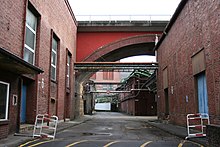J.P. Bemberg

J.P. Bemberg AG in Wuppertal
|
|
| Manufacturer | |
| Industry | Artificial finer |
| Founded | 1792 |
| Founders | Johann Peter Bemberg |
| Defunct | 1971 |
| Headquarters | Germany |
J. P. Bemberg was a German rayon manufacturer that produced an unusually fine artificial fiber which became known as Bemberg®. J. P. Bemberg came under the control of Vereinigte Glanzstoff-Fabriken and eventually disappeared after a series of mergers and divestitures, but Bemberg™ rayon was still being produced in 2015 by Asahi in Japan,
Johann Heinrich Bemberg had a wine trading business in Elberfeld towards the end of the 19th century. When he died in 1790 his brother Johann Peter Bemberg (1758–1838) took over the business. In 1792 J. P. Bemberg changed the business to selling Indigo, a red dye, oil, cotton, linen and wool. He married Maria Theresia Scheibler (1774–1843) and they had a son, Julius August Bemberg, and two daughters. The business thrived, and in 1813 Bemberg took his son-in-law Friedrich Platzhoff into the company as a partner. Julius August Bemberg inherited the business when his father died in 1843, but he also died in 1847 and Friedrich Platzhoff continued to run the business on his own.
In 1865 Friedrich Platzhoff founded a new factory in Öhde, a district of Langerfeld. As the business continued to expand new factories were acquired in Barmen, Krefeld and Augsburg. For almost a century the company was known for its "Turkish Red" yarns. It was one of the first companies to engage in mercerisation of cotton yarns and fabrics, and for a long time was a leader in this field.
J. P. Bemberg began to produce artificial textile fiber commercially using the cuprammonium process in 1897. The company went public as J. P. Bemberg AG in 1903. In 1901 Dr Edmund Thiele developed a stretch-spinning system for J. P. Bemberg, which began to produce fine-filament artificial silk under the Bemberg® trademark in 1908. With this process J. P. Bemberg was able to make rayon using the cuprammonium process with filaments of 1–1.5 denier, comparable to Chardonnet silk and physically superior. The process did not have the flammability problems of Hilaire de Chardonnet's process, but could not compete with the viscose process except where very fine filament was needed. Costs were higher than with viscose rayon due to the need to use copper salts and cotton for the cellulose.
...
Wikipedia
